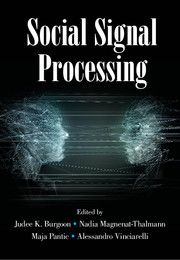Book contents
- Frontmatter
- Contents
- Contributors
- 1 Introduction: Social Signal Processing
- Part I Conceptual Models of Social Signals
- Part II Machine Analysis of Social Signals
- Part III Machine Synthesis of Social Signals
- 19 Speech Synthesis: State of the Art and Challenges for the Future
- 20 Body Movements Generation for Virtual Characters and Social Robots
- 21 Approach and Dominance as Social Signals for Affective Interfaces
- 22 Virtual Reality and Prosocial Behavior
- 23 Social Signal Processing in Social Robotics
- Part IV Applications of Social Signal Processing
- References
22 - Virtual Reality and Prosocial Behavior
from Part III - Machine Synthesis of Social Signals
Published online by Cambridge University Press: 13 July 2017
- Frontmatter
- Contents
- Contributors
- 1 Introduction: Social Signal Processing
- Part I Conceptual Models of Social Signals
- Part II Machine Analysis of Social Signals
- Part III Machine Synthesis of Social Signals
- 19 Speech Synthesis: State of the Art and Challenges for the Future
- 20 Body Movements Generation for Virtual Characters and Social Robots
- 21 Approach and Dominance as Social Signals for Affective Interfaces
- 22 Virtual Reality and Prosocial Behavior
- 23 Social Signal Processing in Social Robotics
- Part IV Applications of Social Signal Processing
- References
Summary
Introduction
People have long been intrigued by the notion of a virtual space that could offer an escape from reality to new sensory experiences. As early as 1965, Sutherland envisioned that the ‘ultimate display’ would enable users to actively interact with the virtual space as if it were real, giving them “a chance to gain familiarity with concepts not realizable in the physical world” (Sutherland, 1965, p. 506). William Gibson appears to have shared this vision when coining the term ‘cyberspace’ in his 1984 novel Neuromancer, defining it as “a consensual hallucination experienced daily by billions of legitimate operators, in every nation, by children being taught mathematical concepts …” (p. 51). While the image may have seemed farfetched at the time, the mounting popularity of home video game consoles, massively multiplayer online role playing games (MMORPGs), and massive open online courses (MOOCs) all demonstrate that virtual reality (VR) is an increasingly integral component of our everyday lives.
Despite some romanticized versions of VR, much of the previous literature focused on its dangers. Early studies voiced concerns about how individuals would no longer be able to receive true emotional and social support online (e.g., Kraut et al., 1998) and more recent research focused on Internet addiction (e.g., Lam et al., 2009) as well as the antisocial effects of playing violent games (e.g., Bartholow, Bushman, & Sestir, 2006). Overall, the results suggest that spending extensive amounts of time in VR can result in apathetic or even violent attitudes and behavior toward others. Indeed, early conversations between Jaron Lanier, one of the pioneers of the technology, and William Gibson, who consulted Lanier while writing his manifesto, focused on this tension. Lanier envisioned prosocial uses for the technology he championed, but Gibson felt compelled to write about the less wholesome applications, saying, “Jaron, I tried. But it's coming out dark” (Lanier, 2013, p. 329).
In terms of academic research, there is a group of scholars who focus on a more positive outlook; the unique affordances of virtual environments actually promote prosocial behavior when leveraged. Recent developments show that even brief virtual interventions can increase environmental awareness, reduce racial bias, and enhance general altruistic behavior. These interventions have been found to be especially powerful when the user feels fully immersed in the virtual world.
- Type
- Chapter
- Information
- Social Signal Processing , pp. 304 - 316Publisher: Cambridge University PressPrint publication year: 2017
References
- 12
- Cited by



